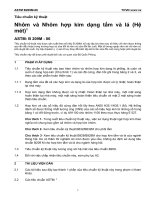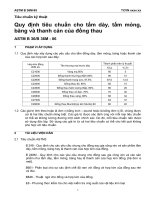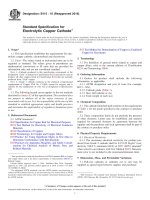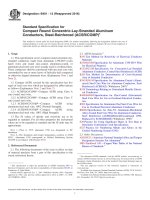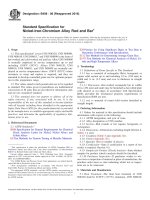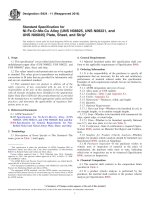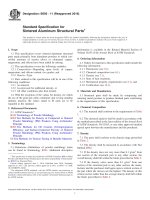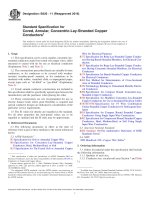Astm b 408 06 (2016)
Bạn đang xem bản rút gọn của tài liệu. Xem và tải ngay bản đầy đủ của tài liệu tại đây (103.18 KB, 6 trang )
Designation: B408 − 06 (Reapproved 2016)
Standard Specification for
Nickel-Iron-Chromium Alloy Rod and Bar1
This standard is issued under the fixed designation B408; the number immediately following the designation indicates the year of
original adoption or, in the case of revision, the year of last revision. A number in parentheses indicates the year of last reapproval. A
superscript epsilon (´) indicates an editorial change since the last revision or reapproval.
E29 Practice for Using Significant Digits in Test Data to
Determine Conformance with Specifications
E112 Test Methods for Determining Average Grain Size
E1473 Test Methods for Chemical Analysis of Nickel, Cobalt and High-Temperature Alloys
1. Scope
2
1.1 This specification covers UNS N08120, UNS N08800,
UNS N08810, UNS N08811,3 and UNS N08890 in the form of
hot-worked and cold-worked rod and bar. Alloy UNS N08800
is normally employed in service temperatures up to and
including 1100°F (593°C). Alloys UNS N08120, UNS
N08810, UNS N08811, and UNS N08890 are normally employed in service temperatures above 1100°F (593°C) where
resistance to creep and rupture is required, and they are
annealed to develop controlled grain size for optimum properties in this temperature range.
3. Terminology
3.1 Definitions of Terms Specific to This Standard:
3.1.1 bar, n—material of rectangular (flats), hexagonal, or
square solid section up to and including 10 in. (254 mm) in
width and 1⁄8 in. (3.2 mm) and over in thickness in straight
lengths.
3.1.1.1 Discussion—Hot-worked rectangular bar in widths
10 in. (254 mm) and under may be furnished as hot-rolled plate
with sheared or cut edges in accordance with Specification
B408, provided the mechanical property requirements of
Specification B408 are met.
3.1.2 rod, n—material of round solid section furnished in
straight lengths.
1.2 The values stated in inch-pound units are to be regarded
as standard. The values given in parentheses are mathematical
conversions to SI units that are provided for information only
and are not considered standard.
1.3 This standard does not purport to address all of the
safety concerns, if any, associated with its use. It is the
responsibility of the user of this standard to become familiar
with all hazards including those identified in the appropriate
Safety Data Sheet (SDS) for this product/material as provided
by the manufacturer, to establish appropriate safety and health
practices, and determine the applicability of regulatory limitations prior to use.
4. Ordering Information
4.1 Orders for material to this specification should include
information with respect to the following:
4.1.1 ASTM designation, and year of issue.
4.1.2 Alloy designation or UNS number.
4.1.3 Section—Rod (round) or bar (square, hexagonal, or
rectangular).
4.1.4 Dimensions—Dimensions including length (Section 8,
Tables 1-4 incl).
4.1.5 Condition (Table 5 and Appendix X1).
4.1.6 Finish (Appendix X1).
4.1.7 Quantity (feet or number of pieces).
4.1.8 Certification—State if certification or a report of test
results is required (Section 16).
4.1.9 Samples for Product (Check) Analysis—State whether
samples for product (check) analysis should be furnished.
4.1.10 Purchaser Inspection—If purchaser wishes to witness tests or inspection of material at place of manufacture, the
purchase order must so state indicating which test or inspections are to be witnessed.
2. Referenced Documents
2.1 ASTM Standards:4
B880 Specification for General Requirements for Chemical
Check Analysis Limits for Nickel, Nickel Alloys and
Cobalt Alloys
E8 Test Methods for Tension Testing of Metallic Materials
1
This specification is under the jurisdiction of ASTM Committee B02 on
Nonferrous Metals and Alloys and is the direct responsibility of Subcommittee
B02.07 on Refined Nickel and Cobalt and Their Alloys.
Current edition approved June 1, 2016. Published June 2016. Originally
approved in 1957. Last previous edition approved in 2011 as B408 – 06 (2011).
DOI: 10.1520/B0408-06R16.
2
For ASME Boiler and Pressure Vessel Code applications see related Specification SB-408 in Section II of that Code.
3
New designations established in accordance with Practice E527 and
SAE J1086, Practice for Numbering Metals and Alloys (UNS).
4
For referenced ASTM standards, visit the ASTM website, www.astm.org, or
contact ASTM Customer Service at For Annual Book of ASTM
Standards volume information, refer to the standard’s Document Summary page on
the ASTM website.
5. Materials and Manufacture
5.1 Heat Treatment—The final heat treatment of UNS
N08120 shall be 2150°F (1177°C) minimum, UNS N08810,
Copyright © ASTM International, 100 Barr Harbor Drive, PO Box C700, West Conshohocken, PA 19428-2959. United States
1
B408 − 06 (2016)
TABLE 1 Permissible Variations in Diameter or Distance Between
Parallel Surfaces of Cold-Worked Rod and Bar
bar shall be as prescribed in Table 1, and of hot-worked rod and
bar as prescribed in Table 2.
Permissible Variations from
Specified Dimension, in. (mm)
Specified Dimension, in.
(mm)A
+
Rounds:
1⁄16 (1.6) to 3⁄16 (4.8), excl
3⁄16 (4.8) to 1⁄2 (12.7), excl
1⁄2 (12.7) to 15⁄16 (23.8), incl
Over 15⁄16 (23.8) to 115⁄16 (49.2), incl
Over 115⁄16 (49.2) to 21⁄2 (63.5), incl
Hexagons, squares, rectangles:
1⁄2 (12.7) and less
Over 1⁄2 (12.7) to 7⁄8 (22.2), incl
Over 7⁄8 (22.2) to 11⁄4 (31.8), incl
Over 11⁄4 (31.8) to 2 (50.8), incl
8.2 Out-of-Round—Hot-worked rods and cold-worked rods
(except “forging quality”) all sizes, in straight lengths, shall not
be out-of-round by more than one half the total permissible
variations in diameter shown in Table 1 and Table 2, except for
hot-worked rods 1⁄2 in. (12.7 mm) in diameter and under, which
may be out-of-round by the total permissible variations in
diameter shown in Table 2.
−
0
0
0.001 (0.03)
0.0015 (0.04)
0.002 (0.05)
0.002
0.003
0.002
0.003
0.004
(0.05)
(0.08)
(0.05)
(0.08)
(0.10)
0
0
0
0
0.004
0.005
0.007
0.009
(0.10)
(0.13)
(0.18)
(0.23)
8.3 Corners—Cold-worked bars will have practically exact
angles and sharp corners.
8.4 Machining Allowances for Hot-Worked Materials—
When the surfaces of hot-worked products are to be machined,
the allowances prescribed in Table 3 are recommended for
normal machining operations.
8.5 Length—The permissible variations in length of coldworked and hot-worked rod and bar shall be as prescribed in
Table 4.
8.5.1 Rods and bars ordered to random or nominal lengths
will be furnished with either cropped or saw-cut ends; material
ordered to cut lengths will be furnished with square saw-cut or
machined ends.
8.6 Straightness:
8.6.1 The permissible variations in straightness of coldworked rod and bar as determined by the departure from
straightness shall be as prescribed in Table 7.
8.6.2 The permissible variations in straightness of hotworked rod and bar as determined by the departure from
straightness shall be as specified in Table 8.
A
Dimensions apply to diameter of rounds, to distance between parallel surfaces of
hexagons and squares, and separately to width and thickness of rectangles.
TABLE 2 Permissible Variations in Diameter or Distance
Specified Dimension, in.
(mm)A
Rod and bar, hot-worked:
1 (25.4) and under
Over 1 (25.4) to 2 (50.8), incl
Over 2 (50.8) to 4 (101.6), incl
Over 4 (101.6)
Rod, rough turned or ground:
Under 1 (25.4)
1 (25.4) and over
Forging quality rod:B
Under 1 (25.4)
1 (25.4) and over
Permissible Variations from Specified
Dimensions, in. (mm)
+
0.016
0.031
0.047
0.125
(0.41)
(0.79)
(1.19)
(3.18)
−
0.016
0.016
0.031
0.063
(0.41)
(0.41)
(0.79)
(1.60)
0.005 (0.13)
0.031 (0.79)
0.005 (0.13)
0
0.005 (0.13)
0.031 (0.79)
0.005 (0.13)
0
A
Dimensions apply to diameter of rods, to distance between parallel surfaces of
hexagons and squares, and separately to width and thickness of rectangles.
B
Spot grinding is permitted to remove minor surface imperfections. The depth of
these spot ground areas shall not exceed 3 % of the diameter of the rod.
9. Workmanship, Finish, and Appearance
9.1 The material shall be uniform in quality and condition,
smooth, commercially straight or flat, and free of injurious
imperfections.
2050°F (1121°C) minimum, UNS N08811, and UNS N08890,
2100°F (1149°C) minimum.
10. Sampling
10.1 Lot:
10.1.1 A lot for chemical analysis shall consist of one heat.
10.1.2 A lot for mechanical properties and grain size testing
shall consist of all material from the same heat, nominal
diameter or thickness, and condition.
10.1.2.1 Where material cannot be identified by heat, a lot
shall consist of not more than 500 lb (227 kg) of material in the
same size and condition except that a single piece weighing
over 500 lb shall be considered as one lot.
10.2 Test Material Selection:
10.2.1 Chemical Analysis—Representative samples from
each lot shall be taken during pouring or subsequent processing.
10.2.1.1 Product (check) analysis shall be wholly the responsibility of the purchaser.
10.2.2 Mechanical Properties and Grain Size—Samples of
the material to provide test specimens for mechanical properties shall be taken from such locations in each lot as to be
representative of that lot.
6. Chemical Composition
6.1 The material shall conform to the composition limits
specified in Table 6.
6.2 If a product (check) analysis is performed by the
purchaser, the material shall conform to the product (check)
analysis variations in Specification B880.
7. Mechanical Properties and Other Requirements
7.1 Mechanical Properties—The material shall conform to
the mechanical properties specified in Table 5.
7.2 Grain Size—Annealed UNS Alloys N08120, N08810,
N08811, and N08890 shall conform to an average grain size of
ASTM No. 5 or coarser.
8. Dimensions and Permissible Variations
8.1 Diameter, Thickness, or Width—The permissible variations from the specified dimensions as measured on the
diameter or between parallel surfaces of cold-worked rod and
2
B408 − 06 (2016)
TABLE 3 Normal Machining Allowances for Hot-worked Material
Normal Machining Allowance, in. (mm)
Finished-Machined Dimensions for Finishes as
Indicated Below, in. (mm)A
Distance Between Parallel
Surfaces, for Hexagonal and
Square Bar
On Diameter,
for Rods
For Rectangular Bar
On Thickness
On Width
B
Hot-worked:
Up to 7⁄8 (22.2), incl
Over 7⁄8 to 17⁄8 (22.2 to 47.6), incl
Over 17⁄8 to 27⁄8 (47.6 to 73.0), incl
Over 27⁄8 to 313⁄16 (73.0 to 96.8), incl
Over 313⁄16 (96.8)
Hot-worked rods:
Rough-turned or Rough Ground:C
15⁄16 to 4 (23.8 to 101.6), incl in diameter
Over 4 to 12 (101.6 to 304.8), incl in diameter
⁄ (3.2)
⁄ (3.2)
3⁄16 (4.8)
1⁄4 (6.4)
1⁄4 (6.4)
⁄ (3.2)
(4.8)
1⁄4 (6.4)
...
...
18
18
18
3 16
⁄
⁄ (3.2)
⁄ (3.2)
...
...
...
⁄
(1.6)
⁄ (3.2)
...
...
1 16
18
⁄ (4.8)
⁄ (4.8)
3⁄16 (4.8)
3⁄16 (4.8)
3⁄8 (9.5)
18
3 16
18
3 16
...
...
...
...
A
Dimensions apply to diameter of rods, to distance between parallel surfaces of hexagonal and square bar, and separately to width and thickness of rectangular bar.
The allowances for hot-worked material in Table 5 are recommended for rods machined in lengths of 3 ft (0.91 m) or less and for bars machined in lengths of 2 ft (0.61
m) or less. Hot-worked material to be machined in longer lengths should be specified showing the finished cross-sectional dimension and the length in which the material
will be machined in order that the manufacturer may supply material with sufficient oversize, including allowance for out-of-straightness.
C
Applicable to 3 ft (0.91 m) max length.
B
TABLE 4 Permissible Variations in Length of Rods and Bars
Random mill lengths:
Hot-worked
Cold-worked
Multiple lengths
Nominal lengths
Cut lengths
6 to 24 ft (1.83 to 7.31 m) long with not more than 25 weight % between 6 and 9 ft (1.83 and 2.74 m)A
6 to 20 ft (1.83 to 6.1 m) long with not more than 25 weight % between 6 and 10 ft (1.83 and 3.05 m).
furnished in multiples of a specified unit length, within the length limits indicated above. For each multiple,
an allowance of 1⁄4 in. (6.4 mm) will be made for cutting, unless otherwise specified. At the manufacturer’s
option, individual specified unit lengths may be furnished.
specified nominal lengths having a range of not less than 2 ft (610 mm) with no short lengths allowedB
a specified length to which all rods and bars will be cut with a permissible variation of plus 1⁄8 in. (3.2 mm),
minus 0 for sizes 8 in. (203 mm) and less in diameter or distance between parallel surfaces. For larger sizes,
the permissible variation shall be + 1⁄4 in. (6.4 mm), − 0.
A
For hot-worked sections weighing over 25 lb/ft (37 kg/m) and for smooth forged products, all sections, short lengths down to 2 ft (610 mm) may be furnished.
For cold-worked rods and bars under 1⁄2 in. (12.7 mm) in diameter or distance between parallel surfaces ordered to nominal or stock lengths with a 2-ft (610-mm) range,
at least 93 % of such material shall be within the range specified; the balance may be in shorter lengths but in no case shall lengths less than 4 ft (1220 mm) be furnished.
B
TABLE 5 Mechanical Properties of Rods and Bars
Alloy
UNS N08120
UNS N08800
UNS N08810 and UNS N08811
UNS N08890
UNS N08800, UNS N08810
and UNS N08811
A
B
Tensile Strength,
min, psi (MPa)
Condition
Cold-worked and hot-worked,
Hot worked, as-hot-worked
Cold-worked and hot-worked,
Cold-worked and hot-worked,
Cold-worked and hot-worked,
Forging quality
annealed
90 000
80 000
75 000
65 000
75 000
annealed
annealed
annealed
(621)
(550)
(515)
(450)
(520)
B
Yield Strength
(0.2 % offset) min,
psi (MPa)
40 000
35 000
30 000
25 000
30 000
Elongation in 2 in.
or 50 mm (or
4D), min, %
(276)
(240)
(205)
(170)
(205)
B
30
25A
30
30
35
B
For hot-worked as-hot-worked rectangular bar 5⁄16 in. (7.94 mm) and under in thickness the elongation shall be 20 % min.
Forging quality is furnished to chemical requirements and surface inspection only. No tensile properties are required.
11.1 Chemical Analysis—One test per lot.
rectangular bar up to 1⁄2 in. (12.7 mm), inclusive, in thicknesses
which are too wide to be pulled full size.
11.2 Tension—One test per lot.
13. Test Method
11.3 Grain Size—One test per lot.
13.1 The chemical composition, mechanical, and other
properties of the material as enumerated in this specification
shall be determined, in case of disagreement, in accordance
with the following methods:
11. Number of Tests
12. Specimen Preparation
12.1 Tension test specimens shall be taken from material in
the final condition and tested in the direction of fabrication.
12.1.1 All rod and bar shall be tested in full cross-section
size when possible. When a full cross-section size test cannot
be performed, the largest possible round specimen shown in
Test Methods E8 shall be used. Longitudinal strip specimens
shall be prepared in accordance with Test Methods E8 for
Test
Chemical Analysis
Tension
Rounding Procedure
Grain Size
3
ASTM Designation
E1473
E8
E29
E112
B408 − 06 (2016)
TABLE 6 Chemical Requirements
Element
Nickel
Chromium
Iron
Manganese, max
Carbon
Copper, max
Silicon
Sulfur, max
AluminumB
TitaniumB
Columbium
Molybdenum
Niobium
Tantalum
Phosphorus
Tungsten
Cobalt, max
Nitrogen
Boron
Composition Limits, %
Alloy N08120
Alloy N08800
Alloy N08810
Alloy N08811
Alloy N08890
35.0 min
39.0 max
23.0 min
27.0 max
remainder
1.5
0.02 min
0.10 max
0.50
1.0
...
0.03
0.40 max
...
0.20 max
...
0.4 min
0.9 max
2.50 max
...
...
...
...
...
0.040 max
2.50 max
3.0
0.15 min
0.30 max
0.010 max
30.0 min
35.0 max
19.0 min
23.0 max
39.5 minA
1.5
0.10 max
...
0.75
1.0
...
0.015
0.15 min
0.60 max
0.15 min
0.60 max
...
...
...
...
...
...
...
...
...
...
...
...
...
...
30.0 min
35.0 max
19.0 min
23.0 max
39.5 minA
1.5
0.05 to 0.10
...
0.75
1.0
...
0.015
0.15 min
0.60 max
0.15 min
0.60 max
...
...
...
...
...
...
...
...
...
...
...
...
...
...
30.0 min
35.0 max
19.0 min
23.0 max
39.5 minA
1.5
0.06 to 0.10
...
0.75
1.0
...
0.015
0.15 min
0.60 max
0.15 min
0.60 max
...
...
...
...
...
...
...
...
...
...
...
...
...
...
40.0 min
45.0 max
23.5 min
28.5 max
remainder
1.5
0.06 min
0.14 max
0.75
1.0 min
2.0 max
0.015
0.05 min
0.60 max
0.15 min
0.60 max
...
...
1.0 min
2.0 max
0.2 min
1.0 max
0.10 min
0.60 max
...
...
...
...
...
...
A
Iron shall be determined arithmetically by difference.
B
Alloy UNS N08811: Al + Ti, 0.85–1.20.
TABLE 7 Permissible Variations in Straightness of Cold-Worked
Rods and Bars
Specified Diameter or Distance
Between Parallel Surfaces, in.
(mm)A
Depth of Chord, Permissible Variations in
Lengths Indicated, in.
(mm)
Rounds:
1⁄2 (12.7) to 21⁄2 (63.5), incl
Hexagons, squares, rectangles:
1⁄2 (12.7) to 2 (50.8), incl
0.030 (0.76) per ft (305 mm) of length
0.030 (0.76) per ft (305 mm) of length
A
Material under 1⁄2 in. (12.7 mm) shall be reasonably straight and free of sharp
bends and kinks.
TABLE 8 Permissible Variations in Straightness of Hot-Worked
Rods and BarsA
Finish
Rods and bars, hot-worked
Rounds: hot-worked, rough ground, or rough turned
Permissible Variations,
in./ft.(mm/m)B
0.050 (4.2)C
0.050 (4.2)C
A
Not applicable to forging quality.
Material under 1⁄2 in. (12.7 mm) shall be reasonably straight and free of sharp
bends and kinks.
C
The maximum curvature (depth of chord) shall not exceed the values indicated
multiplied by the length in feet.
B
13.2 In the event of disagreement, the referee method for the
determination of average grain size shall be the planimetric
method.
following table, an observed value or a calculated value shall
be rounded as indicated below, in accordance with the rounding method of Practice E29:
13.3 For purposes of determining compliance with the
specified limits for requirements of the properties listed in the
4
B408 − 06 (2016)
Test
Chemical composition,
hardness, and tolerances
(when expressed
in decimals)
Tensile strength and yield
strength
Elongation
16. Certification
Rounded Unit for Observed Or
Calculated Value
nearest unit in the last right-and place of figures of the specified limit. If two choices
are possible, as when the digits dropped
are exactly a 5, or a 5 followed only by
zeros, choose the one ending in an even
digit, with zero defined as an even digit.
nearest 1000 psi (6.9 MPa)
16.1 When specified in the purchase order or contract, a
manufacturer’s certification shall be furnished to the purchaser
stating that material has been manufactured, tested, and inspected in accordance with this specification, and that the test
results on representative samples meet specification requirements. When specified in the purchase order or contract, a
report of the test results shall be furnished.
nearest 1 %
14. Inspection
17. Product Marking
14.1 Inspection of the material shall be made as agreed upon
between the manufacturer and the purchaser as part of the
purchase contract.
17.1 The following information shall be marked on the
material or included on the package, or on a label or tag
attached thereto: The name of the material or UNS Number,
heat number, condition (temper), this specification number,
date of issue, the size, gross, tare and net weight, consignor and
consignee address; contract or order number, or such other
information as may be defined in the contract or order.
15. Rejection and Rehearing
15.1 Material, tested by the purchaser, that fails to conform
to the requirements of this specification may be rejected.
Rejection should be reported to the producer or supplier
promptly and in writing. In case of dissatisfaction with the
results of the test, the producer or supplier may make claim for
a rehearing.
18. Keywords
18.1 bar; rod; UNS N08120; UNS N08800; UNS N08801;
UNS N08810; UNS N08811; UNS N08890
APPENDIX
(Nonmandatory Information)
X1.
PROCURABLE CONDITIONS AND FINISHES
X1.1 The various conditions and finishes in which rod and
bar are procurable are as follows:
NOTE X1.1—For sizes 21⁄2 in. (63.5 mm) in diameter and less,
cold-worked rod may be used also for forging by virtue of the fact such
rod have been overhauled for removal of mechanical surface defects prior
to cold-working. In such cases, the user should run pilot forging tests to
ensure himself that such material has the desired hot malleability range.
X1.1.1 Hot-Worked—With a tightly adherent, dark oxide
surface.
X1.1.5 Hot-Worked, Annealed—Soft, with a tightly adherent dark oxide.
X1.1.6 Hot-Worked, Annealed and Pickled—Same as
X1.1.5 except descaled for removal of mill oxide. Provides for
better surface inspection than does hot-worked material and
often employed where welding is involved where removal of
mill oxide is desired.
X1.1.2 Hot-Worked, Rough Ground—Similar to X1.1.1 except rough ground.
X1.1.3 Hot-Worked, Rough-Turned—Similar to X1.1.1 except rough turned with a broad nosed tool similar to a bar
peeling operation and thus may not be straight. Intended
generally for machining where an overhauled surface is
desired, essentially for machined step down shafts or parts
machined in short lengths of 3 ft (0.91 m) or less.
NOTE X1.2—Annealing prior to pickling may be required in order to
reduce the mill oxide since uniform pickling of an unreduced oxide is
difficult.
X1.1.4 Hot-Worked, Forging Quality—Rough turned and
spot ground, as necessary, for sizes 1 in. (25.4 mm) in diameter
and over; rough ground and spot ground for sizes under 1 in. in
diameter. Material is selected from heats of known, good hot
malleability.
X1.1.7 Cold-Worked, As Worked—Hot-worked, overhauled,
cold worked, and straightened with a smooth, bright finish.
X1.1.8 Cold-Worked, Annealed and Pickled—Hotworked,
overhauled, cold-worked, annealed, descaled, and straightened.
Annealed for softness and with a dull matte finish.
5
B408 − 06 (2016)
ASTM International takes no position respecting the validity of any patent rights asserted in connection with any item mentioned
in this standard. Users of this standard are expressly advised that determination of the validity of any such patent rights, and the risk
of infringement of such rights, are entirely their own responsibility.
This standard is subject to revision at any time by the responsible technical committee and must be reviewed every five years and
if not revised, either reapproved or withdrawn. Your comments are invited either for revision of this standard or for additional standards
and should be addressed to ASTM International Headquarters. Your comments will receive careful consideration at a meeting of the
responsible technical committee, which you may attend. If you feel that your comments have not received a fair hearing you should
make your views known to the ASTM Committee on Standards, at the address shown below.
This standard is copyrighted by ASTM International, 100 Barr Harbor Drive, PO Box C700, West Conshohocken, PA 19428-2959,
United States. Individual reprints (single or multiple copies) of this standard may be obtained by contacting ASTM at the above
address or at 610-832-9585 (phone), 610-832-9555 (fax), or (e-mail); or through the ASTM website
(www.astm.org). Permission rights to photocopy the standard may also be secured from the Copyright Clearance Center, 222
Rosewood Drive, Danvers, MA 01923, Tel: (978) 646-2600; />
6
